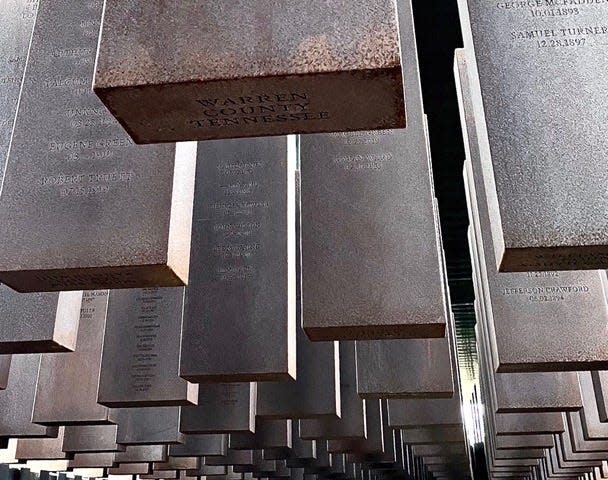Opinion: A sobering reckoning with America's history of lynching
When the news breaks that Emmett Till’s accuser has died, a light rain moves across the grounds in Montgomery, Alabama. From a distance, you can see a structure at the top of a nearby hill — a set of beams stretched across the landscape like a raised scar atop the earth.
Walking up the hill, you approach the National Memorial for Peace and Justice. Built in 2018, it consists of a concrete base with a memorial square—an open-sided structure with a grassy plane in the center, and a green metal roof. The memorial was conceived and built by the Equal Justice Initiative and MASS Design Group. Upon entering the structure, 805 rectangular steel blocks stand in front of you, etched with names. The names of those who were lynched.
You are walking in the perimeter of the Memorial Square, where the blocks are displayed. Six feet tall, about the size of a man. They withstand the wind, the rain, whatever hits them. They’re strong, made of a steel which weathers like rust, but resists decay. After years of exposure to the elements, the blocks turn from silver to a reddish-brown, reminding us of the color of men, and that time passes — but memory remains.

The victims’ names and dates of their murders are etched into the metal, along with the counties and states of their demise. The memorial represents counties where 4,400 verified lynchings of Black people in the United States took place during the years 1877 through 1950. Three hundred and thirty-six Texans are represented in the memorial, with an additional 135 victims from Texas documented during the Reconstruction era (1865-1876). Research was conducted by the Equal Justice Initiative beginning in 2010 to investigate and document these horrific events, resulting in a report, “Lynching in America: Confronting the Legacy of Racial Terror,” released in 2015.
But as you walk among them, passing Black and white visitors alike, the blocks on your right hang over open areas, no longer touching the ground. That’s when it hits you. You are witnessing the illusion of each lynching as if it is happening again for the first time. Gradually, a walkway leads you in a descent and the blocks now hang over your head and you see them from below. This completes the artists’ intention, the victims portrayed by the blocks act out their final moments before you. Unwavering, strong, knowing their place in history, continuing to tell their story to those willing to look. Men, women, and children all were lynched.
Sobering in its scope, simplicity and timely display, the National Memorial for Peace and Justice teaches us that time may pass, but memory is just as strong, wrong is wrong, and during this age of Black Lives Matter, the murders of George Floyd and countless others, you can still learn lessons from simple blocks of steel hanging above a green hill in a gentle rain.
Davis is a freelance writer and photographer. She has been published in literary journals, travel sites and the Minneapolis Star Tribune.
This article originally appeared on Austin American-Statesman: Opinion: A sobering reckoning with America's history of lynching
